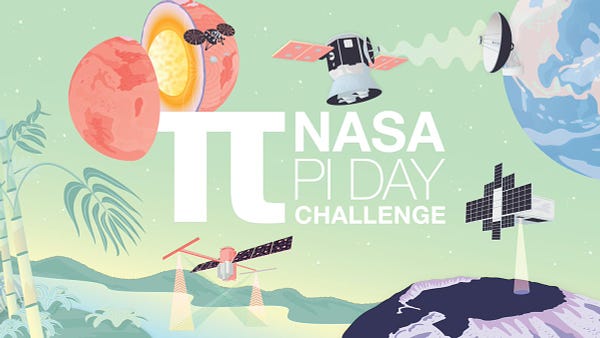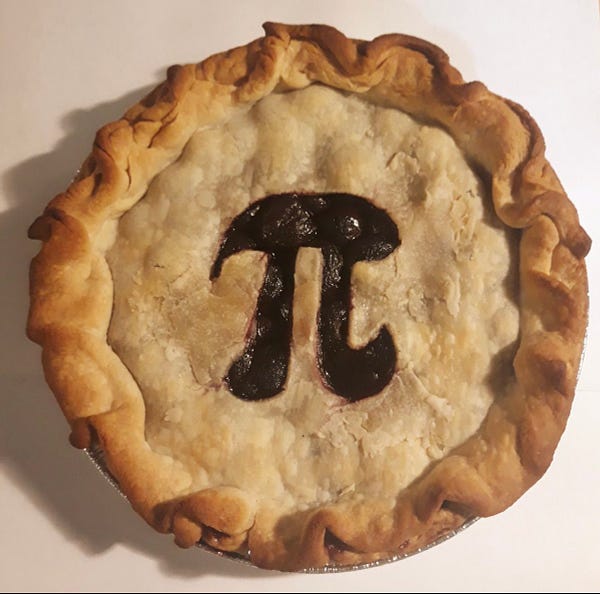On Steady, we recognize that a balance in life must include seeking out opportunities for a little sweetness (of the human kind, to be sure, but also, occasionally, a little sugar).
With this in mind, we didn’t want Pi Day (3/14, as in 3.14) to go by without at least a brief mention here. In times of great uncertainty, we can find a moment to pause and reflect on both pi itself and the homophonic inspiration that fills people today with talk of pies (mostly the fruity kind, but I admire a good savory variety as well).
This is not the first time I have recognized Pi Day. A few years back I took to Twitter with this shout-out:

When I think of pi, I think in part of the power of human creativity. Yes, the ratio is one of nature, found in the elegance of circles. But that we as a species were able to figure that out, tease apart its implications, and use it to build our field of mathematics, and countless other applications, is a source of wonder.
There are reasons why on Pi Day, all sorts of institutions celebrate it from their own vantage point.
From those who explore space....


To those who build ships...



Some approach the day with a little math humor, which is always appreciated...
There is so much ugliness in our current world, so much sadness, loss, and chaos. With pi, we can also realize the power of our orbits through life, and the cosmos. It is a connection that ties the circumferences of our journeys to the diameters of our beings. We can reflect on our planet, and its imperfections, as well as its path through the heavens. We can think about our own circles of life. It turns out March 14 was both the birthday of Albert Einstein and the day Stephen Hawking died. So let us measure and take stock, calculate and dream.
And with that, Pi Day also means dreaming of pies. There were no shortage of creative and mouth-watering pictures online:


Of course, the iconoclasts of New Jersey honor a different kind of pie:
I love all kinds of pies, but I must confess, that cherry is my favorite.
So happy Pi/Pie Day to all of you. And while we’re at it, which is your favorite pie, or pie story, or pi story, for that matter?









To comprehend the power of pi, think back to the Age of Cathedrals. Did you know they didn't have rulers or measuring tapes then? And, of course, no computers. What they used were two compasses. Remember the compass you drew circles with in geometry class? The two-legged device with a point on one leg and a pencil strapped to the other. The master masons of the 14th century used first a small compass to open the compass to the length of a wall on the Mason's sketch of the cathedral's structure on his drawing table. He'd then go to floor of his studio starting at one point on a straight line on the floor and then put the other leg on line, twirl it halfway around so now the first leg is twice the length from the starting point. Twirl the compass ten times and then use a larger compass, one about about waist high, and put one leg on the starting point and open the other to the end point. Then the Mason takes the big compass over to the building site and starts at the corner where the wall starts and this time twirls the large compass fifteen times. Now he has the length of the full size wall scaled by 150 times (10 times 15) from his drawing. After a few decades you have a monstrous Gothic cathedral. Amazing!
Well, pie. I've always loved pie, even more than cake. I had the good fortune to work as a canoe guide in the Boundary Waters Canoe Area Wilderness on the border of Minnesota and Canada, and, as luck would have it, blueberries grow there.
There is no better pie than wild blueberry pie. It is the very Platonic essence of pie. Not just fruit, but wild fruit, loved by bears and humans alike.
I made my campers a deal: you pick the berries, I'll make the pies. You can't have just one pie, after all, if you are feeding eight hungry high school kids. You need two pies. So, they'd go off into the woods, pick the berries, and I'd get ready.
First, turn your canoe over, put it on two logs so you have a level surface. Then, find a piece of beaver wood--yes, it's what you think it is: a stick cut by a beaver, the bark long gone. Cut it into a ten inch length for your rolling pin. Now all you need is flour and shortening. Cut the shortening into the flour with two knives, and sprinkle in the water.
Once you have a ball of dough, flour the bottom of the canoe (not all of it, just enough for your pie crust!), and roll out the dough. It's pretty much how you do it at home.
Once it's in the pan, put in your cleaned berries, 3/4 c. of sugar (more or less) and some butter if you have it, and put it in a dutch oven. Build a fire on top. Small sticks, big flame. Wait about 40 minutes.
Viola! Pie! In the woods!
That, my friends, is paradise on earth.